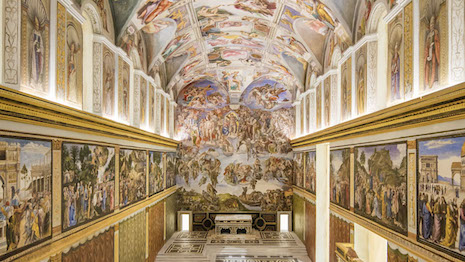Italian fashion house Gucci is investigating the art of copying in an exhibit that mirrors a project from the past.
The brand is working with Italian artist Maurizio Cattelan to stage “The Artist is Present,” a show based around a Marina Abramović exhibit from 2010 of the same name. Through the conceptual gallery, Gucci is attempting to bring to light the relationship between the original and the replica, including the role copies play in extending the longevity of their inspiration.
"The partnership represents a fresh approach to help define Gucci in a way that allows the brand to communicate its essence to a worldwide, multi-cultural audience," said Fred Reffsin, president of Brandgrowth, a New York-based brand strategy firm. "There has long been a feeling that some of the great artists of the 20th and 21st centuries were first and foremost fashion designers."
Mr. Reffsin is not affiliated with Gucci, but agreed to comment as an industry expert. Gucci was reached for comment.
Art of imitation
Mr. Cattelan is known for his humorous take on art. He is the cofounder of Toiletpaper magazine, which frequently works with luxury brands including Kenzo and Galeries Lafayette on quirky campaigns.
Now, he is bringing his satirical slant to Gucci, working to curate an exhibit based around the media campaign for Ms. Abramović’s show.
The Artist is Present was originally a performance piece on view at the Museum of Modern Art in New York. During the course of the show, more than 1,000 visitors took turns sitting across a table from a silent Ms. Abramović.
Taking reference from this piece, Gucci is now staging its own version of The Artist is Present in Shanghai’s Yuz Museum. Including work from more than 30 global artists, the exhibit investigates how copies can actually help to preserve an original.
Among the pieces in the world of replication is an installation depicting the iconic Hollywood sign.

Mr. Cattelan replicated the Hollywood Sign for the exhibit. Image courtesy of Gucci
Other pieces on view include a recreation of Michelangelo's Sistine Chapel and a Gucci Sylvie handbag constructed of Legos.
A catalog for the show, dubbed “The New Work Times,” is based on the design of The Gray Lady. In a newspaper format, articles from writers, artists and scientists explore the theme of copying.
Retaining an authentic newspaper feeling, the catalog will be housed in media vending machines at the museum throughout the length of the exhibit.

Gucci's New Work Times. Image credit: Gucci
Gucci is aiming for the show to take on a broader cultural conversation beyond the exhibit. As such, it has launched a global marketing effort around the show.
ArtWalls in cities including Shanghai, Milan, New York, London and Hong Kong are drawing attention to the project.
Ahead the show's Oct. 11 opening, Gucci filmed Mr. Cattelan in Shanghai as he underwent a visual journey (see story).
"On one hand the theory of copying may help extend a brand’s message, story and lifecycle by 'borrowing' familiar designs, logos, fonts and layouts, building on the consumer’s subconscious link to the familiar," Mr. Reffsin said. "On the other hand, it is baffling that in an industry where fakes, copycats and the hijacking of designs and logos is rampant—and historically a real challenge to brands like Gucci—that a brand would celebrate the concept of copying.
"Of course, when you intellectualize what they are doing the approach appears avant-garde," he said. "Unfortunately, advertising, PR and events do not come with instructions or subtitles."
View this post on Instagram
In a video by @yuriancarani, #TheArtistIsPresent unfolds. Curated by @mauriziocattelan, the show explores how originality can be reached through the act of repetition, and how originals themselves can be preserved through copies. It consists in a physical immersion in the reign of imitation, a land where the core values that used to identify with an artwork in the Western world, such as originality, intention, expression, and authorship, are dismantled. The exhibit will run until December 16 at the Yuz Museum in Shanghai. #AlessandroMichele Gucci/MLBP HOLLYWOOD TM & Design © 2018 Hollywood Chamber of Commerce Music by Francesco Fantini
A post shared by Gucci (@gucci) on Oct 12, 2018 at 9:33am PDT
Instagram post from Gucci
The Artist is present will run through Dec. 16.
Form of flattery
Gucci has found itself the subject of copying disputes. The brand made amends with Harlem, NY-based designer Daniel “Dapper Dan” Day by supporting the tailor’s work and casting him in a global menswear campaign.
Gucci recently was accused of copying Mr. Day’s bomber jacket with puffed sleeves and Louis Vuitton’s monogram designed for Olympian Diane Dixon. When the Internet caught wind of the design, Gucci creative director Alessandro Michele had to explain that he was not ripping off Mr. Day, but rather paying homage to his design (see story).
The label also tends to favor an artistic approach for marketing. Gucci is emphasizing its beauty division with a dedicated Instagram, after largely keeping its makeup line off social media in recent history.
As brands started to recognize the massive potential of Instagram in the beauty sector, Gucci has launched a special page only for its beauty brand. The @GucciBeauty account debuted this week with an original start, spotlighting important works of art to exhibit Gucci’s creative director’s unique idea of beauty (see story).
"True luxury is all about creating beautiful items with timeless appeal," Mr. Reffsin said. "These designs, when done well, inspire discourse and further the evolution of our culture.
"However, the impact of designers like Chanel, Dior and Armani creating art is very different from brands borrowing from art," he said. "When done well, it can make a significant contribution to brand-building and storytelling.
"When there is a disconnect, there is the risk of it being perceived as nothing more than borrowed interest."
{"ct":"5myzPzLgjD+x4U9V5faveN6eTMu3vuEzpZp363dRHc2D8ypSI+0Z1yp0gn4tqv\/Yl5B7ZDwjmNSo7lW4lfJiz6zI+5h3b0j2WLxYUtscz9Pie81NwC2XXsur0fnQBf5uLC2db6AcHHfdn5cGng0OGC8IKh25NUl+rSxpZ4IT1E0FMAsUmQcGyn2fLwXb2ZuzaPure6FyRHBDVIz9aAXB2Kc\/rFFajgWeuFlhG+VcisTMlBAYxfcMsS3NcmLQ+W++Xbh4hDc5s+lXfUEu3CxNhiTpTrEM9sQOpEzi94mRtfC5kCkemMEOWHygQrijP\/RwQaz8h8QSyKXIZH\/+3qwTjPoft1EBNW5cWtwv8Bt7gBpa8RmQVKWcqU4ZMYliAKIYyTXybQMo59\/\/p36L8py71lGsmMpmr1CtsrXJa1TGE8rWh1gp+M+ITWLTh9qYaMrpJx\/VGCaDpInCaccB2+A1S0wbqyHNims7Qg94PABwUPhK02MqhmUjLN4ZtM2cC4VTNfTz85I8fIugCWlJpV3FJ\/PH96f0VHJPLYcGpZcLUlmHzrIes+4gcGnjGrnEXKy\/k3PyfQVzq\/stmpV5AchoFIdCnIgd23ywJcu\/1OS4aKxzfWxpq2bkkDKMAbqjYxOU5Ub9DknRdzp433qSdrAi0g8FHixwycBYfe8usk9MuBFZoPod+XX2oeA6J09HLsApZHByTkI2S62E24wp0IfOzkBMO8aZ\/qphDMeToWH53tyC4DyxVcAcV8D6z7ZqcwdNuPFedtpfPEqbLJ1tFItl3nWK6pfbJPXOxKbg4FGl27TSz8meHxeuPEEWbn6wR8arB7cdtHiToCTn+pMgSco4gPuGR0CEDxqWgYJjPPC5g0lOpEyh3LJccYVqexOLu2L2jn5lgcTj3N7nVqtQweQJWU+0KBGG9m7pwua0ayVLYxi0Dk161UrEiPiU6hP+AdqW\/nJrbxsuvXMrUy88MbjTxU4BOYT0zydZUL7BfutfU5nqE7EP5UX4YBKxZd7mi1og4IfsceUniG4qHfTMH4+TVIQbBTTqvIiSRtg9VB\/5q\/2qzbICwZFPSzYzVT6XOJLHhP1xVKwxFCIoKwcwiL8LSrpOBWrFriaxTpYUlOmySMQVazYXy2Wg5CXmqLYFPLcVvcuxyLXq4FPwlVyPIUD6kPQ2X1auGl51190Mp1p3QDDM4wL9qFZxBp8ifUJFmh8TmbuYo4GNRwQFtmWwwuXDckN+5U2rtZpsuc0tv7TogWc3PZD1tdkibYQlkQ44CU+zcS1AeslG+ZLiXz62y\/+HBN2FMe\/HdtXkCvPB14wA5HWD9Xh6qjpXTFcWsUj\/LJ5\/lvfVIZWTpaqNxvrHVsasPsuq88yIrEM4o60JOKHnf0v8OoLdzEaBKRZj8tOdKMA6V4GYi33315vYoP5xA6RixVtQZszUGaK5Fp02OJ9GxVx+f\/ZQNcAYimsZ5Vx5msT0E14B6+O9uCb+\/u93HO6bEI4wDT8oAQiMucNIvLepCNEY5LdAJMD\/6\/19Ao2gAtSEaDMjon454bwIpjvoFo1+GnBnMPfNkl53RCiTsoVP55N1s5J2jUrTanvHL\/a6GcZFUh+LbwgllQHrriz9Xi3bnBJov\/mNIJeRBgalbsQz+UoYlN\/ChjiHjgJWsk45p8A+v60zNbNrrX7rGKy5h4kbmCoCABgKzeopviZ7FHbCiQ0NA9zfO6JoJJA+pSC5Wck8e0lDJNHCE80rKZ9eWG8lvu\/NS+FCdahbSNnZqyMpFGSIBAkKSVa8lXDrjdudPoEoC8MVlFtKUJq5uwms5UInG+pihg2dLNfL6xdLMnJg6dZvdttkTgCJ9vAz7Yhch3xO2VBTPnorgND7DIcpOyOzAZCFLKwKh8Azx2syD1DwcecMjnp8u0GqFCZ8I5bdMD4iklWOnw0X8xYJqB4wyaIximTX3NtSddd1mtHOJShdMS0G0qTohozB+kGHEIbVZBlef0u5hlkcY\/y4f8HMP+fpTyQ25xoAcczlQCnZ\/DlF2DcB98LgxoQYFZaBRPvdQNgY6xniM1ZbmHoZ2F+YRGAFO5jXy120XCvUU8pcU4As+S4w2mlVVnxySSz5JK\/YhXVv2vTPEEjPkqY0JNmoDG4AM2IVqgteGExhyoo7EJkWahmKpWDcc\/hF6JfgN0pmqA67HtW3X6bvr1pcGpHpPq7D4dfOYqS0s60kgesRgzInkwRnWra2UoQ58tiDsxt6fSqQ8JOcpLkyIdcabnjEqKQA\/qLPAun\/o0zIwmgw2KfNxZkzHK8G3TFPNuW9XFxnSspQ6va7sEtXlobHb4ovbTdj15\/l7wgZePgKH4PcrleBVEQBLbyySkUtUszrJlGfAybpHfajDCKmVj3nRlW78w\/xWBW7+XrInAoky\/cxvSboCnvcaGdouSt2V5NHvu+PJb8yx02pWiQAuzNdWhjxHrI3hxj8Vjqr48CWRDpaR4GlxC0KqY+MCxHEZuRHAre45itkQwou2Nw7I9fICWFfzDD6NehdSQvlKloBgKRvL+4Zmv4e+B05r81M5MBJCTDRDHVrO7WttDNQ4EzZPNQ5aDxd3vvlFfey7YUMwijOn9d8xqEfyYFAqx9gNG+kb6Cmpq8VzCsxMxR7gCvbYrkkrJD3pJdmZCHBTiAGRRNzA99om7rWU743R1WD7SumGNgB3RVTMQJgpCQJi3Jlwe4h+lg1e78Y7O6zcPjzrlS0bgF9oKrOUumTMcm6Kd789BIc2E8dowqmWF7uMuGlVaIvRvmH6OMhnqKleCnhfEwArnuU3BOOp0V0TjlK0fCjjPiMy6ekAC1gNC\/98H+XBzHFXNDtx8XUwFfhS0pskmsNdfEckkrv+qp4A\/edQic4ERUz+gq77KlxHT5EZZrcjRwRgmsyg1z2K5DIFGiR\/vRr3an3Dxe+AA9fn8U9TG1ke0d63u2IZEC34TV8tDcHg5SUfBD9gRYhsuQN2CNx30MiNYuldj8S1HZaQ9JFoMQQfm66Hm0hTCwxLkrknTABhyNx0RzEahJoGxCrX2f6BavR9b6Y7iQMqSNUmIOVuSPWg+RR7PU64JYysQ+PEDxko48MGyjjPs6BG+DLUROi0+e8NGN9+zTvvyFqbFBtAEy69CCmbztq3F8V7uzJPtk1pDiecN3ufQZjkgpXvW3AXOPfNf9z13MC0EEIov7Jbke3uVzIqfjkERy7m5lvTWJHe45IZluYtYb79XAekxK7EkE4r8QRnhx6j3sakXCxDCNek2ptgPzWkJnHqfz2TmjRybPD+0eryqCYbPsbVMhdJXJMKumLKZvB100NvafbfFzh8Dtv0HIM51cMGfGlj23bMFG97AphIi0EvECOovdhjlF31jqX0+woCdX\/6Kro6zIR9EvtoZnzCewS9fZyvejoXCJljOklHjN49xrQxD51ise2L5q+X121qym\/EzmJE\/HDq21TX4zCTDqKBPHKPJT5SJ5K+gX\/NHAU5831wXv9Z3JZpqTrYw4AycgtbDvAgkepm0mSQnz8ShUINJIMI7z7cgEDShaTPFGMQs+vAPVHCAvGEgWz8aN\/z2jIvZrorvMR9xuBHFus2P03TXDDhYIyy98UV1Jy9LoVELC8mcbw1eTppEKlnezj5H5V0B+ABw8oEtoWmpGWVuN8L0pM5llmzdL7thrrcgKuljuz0V1lBYcNUDXMqDa8Kmy9jvdKVE51R6Hvv3G\/8ziB3JyivLegP11GHAZQvLHdW9wD+JhyGC6eGaOWHeX8XmUDNHUSkYaM25cnW7q7k9AFBMTfP5oNOkCy8npWizySeMQ\/8jVOeUcSEo7A2VDCHxfm27EQMrpGUh6GexqOZodwAmvXhUcwtjYzTXjYDKQKR\/aqT+Fnd3mN7Ceg9OwGig1KKLr9caUi1trtn+8RHNn6+EiB33o1aBGPVEqZ+sGt5WSS2XXJZo0HXvy8XHBfYvzECGVUdxhnnGzE6wIAEuoddgOfHTuxyV+4t71ZDr2Di2ovt2MU60COp+cB54ORVWoVJmXoifJ8fvA31hfNXejXkykYxXBFwvb646pzJW8em\/Dt66cLlKOgAaQEGwMckP45hGrGt87gWOP0WuNFYGQEjwnmiEdCAS1Ajo4hOtUouChhfXiUlF24opwDMLMnFWnWmb8YIlNC6LpYWdpebwlOLrm3ihJBPCcENsUMuQ86FlRlP0oATDMhdKFJMpFpS1JyjCSR5VRCkulZklcTOcigbbLhdr7KAv1ti+kjc9nwuYP3e5iGLxH7+YWFJucrKw99lcKwa0D1nddGxlMOe80Q58vcQR\/\/dEYCOWfSRPNX\/NhLI7qsDxO3oAMyYOIyHO58DHc\/nwwg0jYEyhOsjDoxoVVXNwH+pKzHsa87EsshTcok0vgXg36HQtO6NfvKDciRsB41bGM3ORrjQAping0vYEBnLNvEqZan4hYZVIp9CvU8qNeSUViISWXazDOQkEGAC75+c3JtMLC1yTIuOqElCzAtZAWCqTPOiabHwOYAQzE7qegRXXyaLfTXVQr4cJzIu6bIorVoKWWT8OgvMKDkOg1OKp99ckWYWmP69Rs\/nyZ8xYEc33\/Cp5OGIWMVrMLhHqZOpWBfo19yp2WC8VHT8dQgdp6j5\/Q3ZwxQV2TEjmL\/wmfWj0nVMhY0XKpAE\/xumruOPyEglL3HVNvW2O4g6zkX\/4+gn9VNg8jSKPbNGPc6YnOzjl6jlMwR+WRS6e0wptku2hK2un2U1RTNK0vBekT9c6MNroAXY7qx2WaJ7ok1Y3waasWb9QQ2HzO6kkrV7GuZxDqmAkGiIju4G+Accq7nuz+yB+5EH8IZeK073KVpQ33JAVibI6GMGr\/5qLDV+Ln90Ef05CmL4ZPbWSfoqAqoI\/35qUX\/MPbRpu4SZPL29F9yD74QW058Kz3BQaoEctVVHE9m2dwU0vh1vIElGoPDzHmGFEVTVLTaQFlyWFiUNEftiSAH1apWg4VJK+hfOL\/a1n4H50n2uY88XuSMXKw0UmZ8NCXgJFEAxPAzsNzOZ1h+gbvzzwQK90YrRAxgdnPOtRg68U2Ypcw6afp0bJavastffTofFxcID9muViLJntAiF\/fto50nKitDldfwlINExRO4IDFLzXhU3l58wEc1twrvli2UW73WpOLupSVlZgDO34T708vDOWpWOh+H6MU5Wa2siKlNr2vDqsaGzeVl8yhniH65sdXL2NvUmipmbom4nh7PZA9MkMHIIO0yWLqgpxGJHMrrzSbEAJkYc9C3F06L9jIhgc2IiPra1rFpGIoTONZjIgd4ltrewMBu\/vprNSIqeNgFF\/XyBkZz\/KjhdIT+K+eUWPlIZnm4LLCphECScTWXs0dxFRVAGML5CKcZ83p+sau\/HridZ3obCyF1VY8o0CW0YqvXNSk3EUtKw1jpVKzZgBRNrImbLHfHVpC6HlN84RURNDuAJjf+d1ZaUA5R3DPHauC0SFu8yDtCPjquHcTqgOsGgM2CmsiTQJ\/sXTyfMj8N30+xwU2qY11UPhqqzv5Rst5gJaF3UaR8C3jQH0sy4MKd906Ew\/jhnKa+7knmSv+uno\/7ab89fmsO1qfN7QrgKKaKD6OueXBqPOnPji1lqVhTKNwsMC7igszdrZM7BYciZPtxyTav62S91Gjla9ZmuRUtFW8+DcwLpBAyqf4WiPS7mSNNelwEUvppOGNRZ072SwVK4xnfv7ZxeVBYm1AX0Sjx0PUb797nfb47RnttqAUE2eJPdHJ1jDRjDpK8gS\/euCeCIiumLm1vwyDSCIaQ7q0aT\/PHCXwpJm+fD8irwI9IEo8WyYd\/nTi+Z4XUQdIkOZnmt7fhM5lDp8\/isAkBLwzTCyqMSKGJrWku41IJ+TOpSRFtGAVgoFBrhT83Ryjy9xeLgiSFy+nceSnPQWWPBK4HOf5ceR9MyUkjQ+EeGaOq6E+YeoTnuEZ73v609Xnn8fB1we1xLHygng1Nseo2O4y\/0+aBc5F9udBL45wG3+TSruOAwB4nhY3odDGIaf8IBoCmquORUD917y7dSDoCts5U0dKBYhK16+QIQ3y9E2PI8COMXlR8ESGVXkXdk9fWSTg40FyKhuwCchnRD\/urO8uFJ41RvIeFdK6blcn0960i1AlgMuUdODyxawqBvnE0NQ9qswUJWsjUz1XRVEjo5xJ54kjG\/CWfEaBBqTexOWiaLYI8KMzZigaHRfYjWTSbdB9HT3UZ+8G+V5FGS7jUiG6r9zhoUBPFgCZ3rd4IOMyLrtBr5dUK7F5QS3eAQNgdc6xa5PfB68hTbmtYCrXXkxWtV9rl66GzghvRz\/3uReIFo6nW0PQgNFsX3uAxGCyvBjgMk0bXb7ohLaShsJFu\/p7u9gdU4Po+rAdnWFin4UwjuPhnfk+JV6wHZ3oqAF2NEPKxiBdyY\/1kWbA75c\/0AP2qwzH9r5EY5L+yXrSERrRDCypu0tS2P4KFKzAHEFPrZ0nQwOtIa0V8kqtKclXjheQ6vlJq8qqQNNCjQV3gfWiBye26uZvTOvAp1LIQaDWDJSO0CVuRuuG1jc\/AVS0iOcRiglnDtWpKm9rm\/fwk9tQeGUsVxhFozpk5LhFl6qTgsZn9z5jet75kATiFbR0Sf\/IqjP\/\/L2\/O3YvkMWhQ4wNMTBmag\/mYb+5lvko33qCXYozJvGI+5blD\/S5HVlsiPJ3So21PuX\/p8MV9OY2wyiWUrH9PUZzENshgAT7cbmBy4s3aN9oWTG6iwl7kg1+B9CZ7qqbOo42hmbObZXZtiVC\/qmSiZrrwVwtiT4Ay5qB\/jRFrSMmua\/oGD6TOR5qk1evy27fjD12uzJv+oLcWlE4+Z\/+mW6J+bMT8Ddap+Qc24RGJ1i6\/bsfcuWl3\/LJVqjXs0\/RbU2d7i5ckQQN7FKs0dt1eC9eBsqXLNk01BPsmkfaWNlV++sIcDr+u2CGSwyt8qCmbJKdE6tI8R4B6SBnglykhY7HE8nH7llMTWeF974qpOddENC15dXiXG1xuLFEmal2Fl1KDmDlcxbybRUq1hajgHiF0N9Dk6tnceAUrIyHCpve8H6fAVZeEF9G89WTodiTaKkDpHabphjYlI\/ynYscvhbf8P6cUUfM6\/SaJYsSt4aE\/HIwhe6FMPmNl3NIkEILfZLPoEr\/MJUBtm2uuyQWFHSAsHNHW2q5A0znsfs\/irnvlPs6YybpHo36K+P7X\/uflydcsp3hzZAsdhDVOkUbOLoZ3uvZNH3QKjePnzZxtnd8yLvU4G6H2ebidO14kpsvlSUDVBxeGeW3ahPa2\/436C8dE14emfrzQknw4aPNYSBLCTiNJhjUce+TZuaGkWeIBAsBNWV65jOP0jElham4wGUiE2udNdcUhMM9cqXGAuGi5uoUY\/E+u48h\/uxPPodiW6mfjHXKXQeeus1VI7bLXhWl50W9wcvdUhQJ9KhsAluPguMZDSCuFTMmpE4SzwKEJVDvFSMhZx+60QQzZOVq7X3i+VEzO4k18tqiOdLmIJFi66DixJZrBfdWt9KEJpCfvva5IJ\/ptTy8znMmvVbhffpMzFFpHQgzh5QIYA9cQitfs5wKois6HcZYRA4o2Pr7aNaaJ4wsZNJ9qm3FlSSHxmT6wRw7zIXAyS4MHNRVsilSxXObCFQ+AQRiXwFx5hRgLO+EW+jMxbvB3ndAKuflYYd4F4sf+JSKQ6edMG27PlTXRNXcnRQrHZZGNTUalOqBy0Se9ZuSyTAORwXVkJCLOQ5HnsCFuQjznA1RouY8sNyX7qOJZ3iG2IwYKKVE8vkL94o5Nuh3EQUQleZQUEFrMRCZ5V6+v373anThGwbbgQxFTsAQH8IQX0oT7S9DFJ8ubeexqkbmgBmVWUy\/+K2CU31KQOSt8nkNd61jMYZJxCXNsbp9eFYAuylIxAgWIMG\/3m2Ac9R9SQHtlwH365ZaK9R+ofmwmoJUHlxwtKnmvoL4SEx1zkM4TIuADBB51ML1XH7+lcMQZ7DofcvD0SR\/joqw2YRv3ruKzrPMy+bLrQoYzvz6vMHb8H\/nFUsWF83FJuNZsbPT2m6fYxPSDmoPL6qQR8YGKPUj6T18wcFHXQ9InSfSYXHmfHBWOJYPb+4KyZniJxlXD1WJM21RtUcVc+JiJSQvUot090Ezeg2hjBa7dsoHVDq\/RlYxnigu5LExm0JOcyCj1xU\/JdR\/jxX0+4M3E3ON9dUrCyRaj+CBn6BgiXoIFseQIamhi0spdY54YZEmqFdihDIBWFUHniAGqjR3oWRgqH+hGH82zqCmYB4Fu\/h6\/DKm3eM+DPYmN5BBailEH1fqi3VDLxntSAk9RMBDKz43KAYkSXHyce6hEQgKk4YT81HtbBuGaCpqnhh\/1tetH6r\/xqeXe7X76uGEpa4tt1llYTW0UBdwUmcC40Bzs9P9E5TD0icRpl5bCKOpNLFmdFwHhOwDK8Qq4RX6S1Y10bbYvHIOpYjWrY\/iqF8uI8nrDu7bU9kFBAM5g770SzooL3RxGuX94fnxdtOX70aNzZpOXm8RgFRuttgASBusODpreKm8G1EarXy58hVAoKKP55piXcN2q+ViV\/c5FkyyWMplt0bAQy4KUHK8O7z75IZunQVXHoFnzNgf0pDzItFn94\/iR\/Y7RB8e+QRk7iMZDtLszA9RRwE+WczkLve\/AcA7yJ5n7UjGxTVe6LFVl0DwgLSCkra6e1t5gUiLZvLhUZIU0DYKlZN2WoWIn8PQObHqQGHEoIFGDxjPk3Ov4DZqI\/b\/WWOYH6JvXIKVM9iTfxZ9diG1RdvWMWCQJRLHiKffSh8TktIF9T8g9HywNfM4pzO6Bst\/hke5kEwJxByMmx8kqwgBlrs8rY8w4EcOCp1RxIwh6hMJcTJ6f2qJokm9kxYfRdGSgM5QOan1KT5Ncs0IVuzd\/uc2frYaQxW9rNjUPAwzteBgBkzPVvv8lHBuOeR\/jZzDv31AtP8\/GwzTuR0KG48iNZUM75kGhC0ehuS94CM84aPAA+TvQ1mnCJKQfPNHW9GKuDuN+4aosmEshoDeWy0PLvBkPlhLDaF9DhMOW3d5wOy99oAT3YPUeUrFj6E8KOmThsAd3NEgTaTD4Jmws61H5yfWUm7+GNNzinpKnQdwUi8HHi99AtXB864R5yC\/MJ9oUfKcMrYm4LP9NaoOUKA7xpnZAqIe3z00EfdTry\/EzPl7YwEgasJ9hM7zMkdC+lwMUHUP+XlR07G3wfR3XHOCdRldZZPRYbWEuYtGrv604wWBfEbBiIsArSwyIz5SVYA0qWqdgp0WgXMDFSyrqdnMKv8gXbKfZUk5bJaV5uujpS102+3IPr1srrJhE6IsrdhGFULcfVn7o4WvQUbz87zWeAU5Y5sAbnY4ONXHbn0z8JDOv1Yk98pzV0W6mY\/jdI9a7LIgtV2sU8Xd59J3ph3wz4phQpflIm9BQWc+Batykc2G\/k8y3cnHrfIRU4IkhMaC\/jFT9cl4\/DC4TezTB8kiEeM2paeeMhsoILiCIEJJmFHQvXAFy\/nJR7T31g4ejbJpo8OZ5KhIksCqZRXSRxoE96s+2oplS6kkHA7VWV+ooHaD+vGokz0jQPwEFGVqCGzQKUiVNefZLApycy+O\/Lv8\/IlrjJ1WcjF2G9xYCCyR01Pc4aJhbNEWJDm\/DtxHO+Bgdvk2dbx0U0y226ZVXZGCvaL67zyRQtDgHyCRp2JC2S\/o\/NuEtJ4q9fsoceV1zhw5vTCp5ucLwCTaBH3xQtqABypM2fbXYw340tJ4AiOk2VIk0B+\/Z6R0okGTIRgOR3IkoSz7mE1BLfLq1EbHF4KXqCMBH8X4d0wuadeo8CO4+BZeVT1Be7zlmH6vpUsUF62U9BqtC9hOhSPnp4iBScfD7y0ddLcgfeqkAFaQtSE5RFChZDg3Y1BKVKmIxpKvVz4q81TOvNstDhy5\/QbXG2sjUOyKAhLXCCdFm+CrxVHNQOF73yWC5llO1\/g+fnRXvuuhlyM+8uHBbMnFAYoi33LSjdwfWvnaiMArKu3DPMlyzLRkyhxo21ETbVI7zTIsDZDaKT2aLtjEEk4RWaoAZoaKks778yMEqZbNn5F0bvxRWl4gMDx3s2PgMeytqxF5iu\/21vN1SEJDEPTLf3znbXfxR0s8UGPGQeIrN2vYTepTRJdU3HwgMr61jmpXvGGyglCmmXc6NCuGQFDtWH2NQyGHCf\/GZCofATv\/g8p\/verEcnurEuQKjLAz3y6Mj1acasAARTTM6QQqCj78uN41r9OTwfbJ6Si2opmMjOqtA\/NxjOm4ebCR7fZgMabjLzynb6Jy4LS7E5v+o6wdiMT6Mo9Da7t7kFviV9fVl8OG8t\/iM0Rz4xVTxJa2CSf74FfAEWX6tMjvRD8PrxOGRirRSdBgwhtAcGrqIwGDgWkCat5f1FZGrok7aDF3TqZMcY2+Rvu65SE3qwMf8Jn0PpXGklsOqc5mB4Uc+ivlivRBPPKMIJ4PSGBVohR\/uSXqAZixVMY\/z4plGX5O3Uqo1a9CiBPcgRi26Hx6ZXF9E4uGPHjJmEfm1InepMLwTAgU67Ig1+qAn5CKjrYqiPsTFlDg++jcwRCsVn4fknUJ7gWX6TZHRLhijKOYW13w3UKQ4HavsCdwNB+eiOchQm5lWruNkOqlzVmUEKZ4ioqKuHQYPyvom3Qbx2a3pJ8VxoInKuDd0HUths6sye8UIdy\/H7iq\/CFQu6LctOfSWcpOiz+voyLwy1IHDYCFHt54C5EaBQNUAAw2o4MJ\/I6X1LAHZejz\/8fZ4mspln9\/Sv4NFnThrIxVdqhsonV79jTBZEJCr+Sb6AmCOS3GJAtTrFHMVyUgmLuifROfn48p9N4agS7u7i34t+\/0lRQR5z3NJh1uBm6p6g+rvBBVGh0G3yUXvdim++YJhHIbkVJIrvP0x2CUBpADad9cMer6i1Yfrco9njojdZwAmBPgLnEvB9a2QrDSiIkbN3K5a0YaLTD2Jrmpmk\/t7YJXgsGouKzn+y72Nt9jMFHahfY4HozSqI+OWs6FDg58isLWyu9+4BvEakqBsWeKCcXoPwUlcBF5O6NsUcXMztQizpixzjPd+VM5GSbj5h91DR+HzR4x0XS8COT4YQ9D3PyF1BfcQ+J6EcvZgVD0vULApugN3KIFox8112STvscgTzb+I6elfan5H4j5UmxoBrai5ohCvCpAotU9zJrxycUP2w504nxb\/zReBl0yOS0dJvdLDRPlUJEP4l9I0\/9DbT6bHTZlardhtYWZJTan6QieAR2+dl7EEmy24g85P4RoENyEU\/qzjfEJuhoKLalf8EWpD+xkuVxzuIAORB5+zis2RqVBZgKCWMrzRQWy2evFggPCBRqFCWNTxkSry5EyFMpzLaGuKRTJnG1uwpBEbh5UW0ybp73SPMq1uV7XuTbqxR3auPwLTD8Hc6mT6C+TULuQBAaTE4T7e5JhC4JxGHCmpcdyc0q7ks6a9MeRNEQv0u5YF\/ruw+2i7\/OIOm+O8kM3AB2uYT2xhTaP7ROAvkwAUZEjSlDV8wGWxKMLjh1nPlmeHNYy2GNcvZHNa4wIDMUU1fTDLQMVtyD7P1wyU+VZB3wVKIxvWkzLgRtHkWjgAxDyX7vPyl2+lTi+OY7\/BfqQLhw2VbYG9xZSFe43Lc5fv5rTPaYwMgBTXJq2pnBndik4tgFJvsYo4t8OBtgDuavwyOOJs5sFQ8UW1f0ljmKosol0FvvPZyli5gA9o0X71nqzT+hDLNUlplvA8unk5piKCROkbztvm2NCVkt1L68aiiNl9b7ReRl4F2guqwCkXBqi1ogM0z1Io6oNsGeynWAfNQkm6FR0iKBSODUqTC8Fqc+7qdsybXX5IAdvTmnwJc5B95u3+mDOwVxkr+IrReGpAoE1k0Jjub0GElEh3MRY6QSSCgVfJqd1KYR3yqbX1BKKSUX9gzwSa9v8PXdnEAeT2NA\/ICHQEfSk7s0sLg5t5UYm7dBc0md1k8AUAdujIqh29AHmEupLz3U56kAyaxXi5v6TGuOCzG32F075WexM1ckBvOj3knnEDwRv5YHePnSU\/V9O4DUjGj5XylHtj3f9ZMZcWiWTcT26WPvlaI4nrrfnHaFG7wDLVmHX+gb\/PhZwJr18P","iv":"dff480fb1c5d9fb0f3385b69655fafdc","s":"0007a4f2a8b1e619"}

 Art by Maurizion Cattelan for Gucci's "The Artist is Present." Image courtesy of the artist
Art by Maurizion Cattelan for Gucci's "The Artist is Present." Image courtesy of the artist